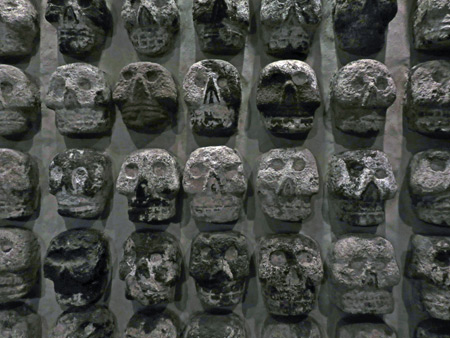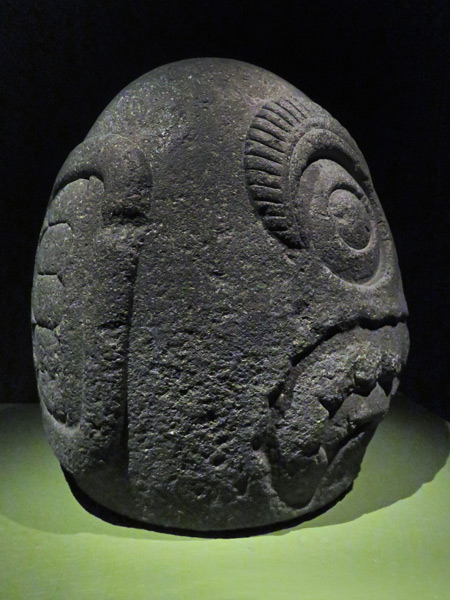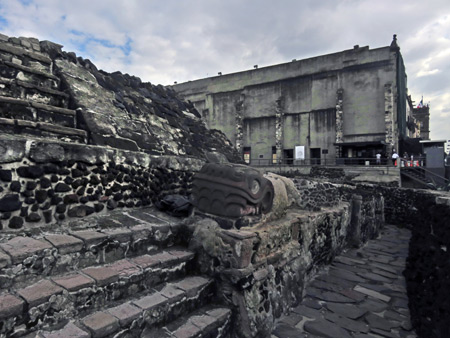Is This the Isthmus? Tour – Mexico Part 20
Tuesday, October 17, 2017
Mexico City, Mexico

A large Aztec sculpture on the ground floor of the Museo Templo Mayor in Mexico City, Mexico.
Today, I visited the Museo Templo Mayor, which was built on top of an ancient city-state called Tenochtitlan. Easily one of the most glossy and glamorous museums I’ve ever laid eyes on or stepped foot inside, the collection within is spread out over three huge floors. Boasting a wealth of carvings, jewelry, paintings, pottery, statues, chunks from temples, etc. it’s all presented within a totally modern and attractive interior.

I want your skulls at the Museo Templo Mayor in Mexico City, Mexico.
There are also plenty of graphic timelines and explanatory text—some in English—that detail the whole history of the Aztecs and their ancient cities. Close to closing time, I rushed outside to check out the actual ruins of Tenochtitlan and its pyramids. All that’s left of the latter are fragments of the bases, which are slowly eroding away amongst the severely slanted ground—the result of the whole city (which is now Mexico City) being built on an unstable lake bed.

Ruins at the Museo Templo Mayor in Mexico City, Mexico.
“Tenochtitlan was a Mexican city-state on an island in Lake Texcoco in the Valley of Mexico. Founded on June 20, 1325, Tenochtitlan was the capital of the expanding Aztec Empire in the 15th century until it was captured by the Spanish in 1521. At its peak, it was the largest city in the pre-Columbian Americas. It subsequently became a cabecera of the Viceroyalty of New Spain.

I need your skulls at the Museo Templo Mayor in Mexico City, Mexico.
“Today, the ruins of Tenochtitlan are in the historic center of Mexico City. Its architectural style belongs to the late Post-Classic period of Mesoamerica. The temple was dedicated simultaneously to two gods, Huitzilopochtli, god of war, and Tlaloc, god of rain and agriculture, each of which had a shrine at the top of the pyramid with separate staircases.

Profile of an ancient stone nerd at the Museo Templo Mayor in Mexico City, Mexico.
“Construction of the first temple began sometime after 1325, and it was rebuilt six times. The temple was destroyed by the Spanish in 1521 to make way for a new cathedral. Today, the archeological site lies just to the northeast of the Zocalo, or main plaza of Mexico City. The site is part of the Historic Center of Mexico City, which was added to the UNESCO World Heritage List in 1987.

A serpent head with a human for scale at the Museo Templo Mayor in Mexico City, Mexico.
“The museum of the Templo Mayor was built in 1987 to house the Templo Mayor Project and its finds—a project which continues work to this day. In 1991, the Urban Archeology Program was incorporated as part of the TMP, whose mission is to excavate the oldest area of the city, around the main plaza. The museum has four floors, three of which are for permanent exhibitions and the fourth houses offices for the director, museum administration and research staff. Other departments are located in the basement, where there is also an auditorium.

I want your skulls at the Museo Templo Mayor in Mexico City, Mexico.
“The museum has eight main exhibition halls, called “salas,” each dedicated to a different theme. Sala 1 is dedicated to the goddesses Coatlicue and Coyalxauhqui, mother and sister to Huitzlipochtli, respectively. Here are displayed the first finds associated with the temple in the 19th century to the discovery of the huge stone disk of Coyolxauhqui, which initiated the Templo Mayor Project.

An exquisite Aztec temple carving at the Museo Templo Mayor in Mexico City, Mexico.
“Sala 2 is dedicated to the concepts of ritual and sacrifice in Tenochtitlan. This room contains urns in which dignitaries where interred, funerary offerings, as well as objects associated with self and human sacrifice—such as musical instruments, knives and skulls. Sala 3 demonstrates the economics of the Aztec empire in the form of tribute and trade, with examples of finished products and raw materials from many parts of Mesoamerica.

A couple of large figures loom at the Museo Templo Mayor in Mexico City, Mexico.
“Sala 4 is dedicated to the god Huitzilopochtli. His shrine at the temple was the most important and largest. This room contains various images of him as well as offerings. Also located here are the two large ceramic statues of the god Mictlantecuhtli, which were found in the House of the Eagle Warriors who were dedicated to Huitzilopochtli.

Three Aztec statues sit at the Museo Templo Mayor in Mexico City, Mexico.
“Sala 5 is dedicated to Tlaloc, the other principal deity of the Aztecs and one of the oldest in Mesoamerica. This room contains various images of the god usually worked in green or volcanic stone or in ceramic. The most prized work is a large pot with the god’s face in high relief that still preserves much of the original blue paint. Sala 6 is dedicated to the flora and fauna of Mesoamerica at this time, most of which contained divine aspects for the Aztecs Also, many of the offerings found at the Templo Mayor were made from various plants and animals.

The base of a pyramid at the Museo Templo Mayor in Mexico City, Mexico.
“Related to Sala 6, Sala 7 contains exhibits of the agricultural technology of the time, especially in the growing of corn and the construction of chinampas, the so-called “floating gardens.” The last room is Sala 8, which is dedicated to the archeology and history of the site.”–Wikipedia

The Palacio de Bellas Artes at sunset in Mexico City, Mexico.
Words and photos ©2017 Arcane Candy.
Leave a Reply